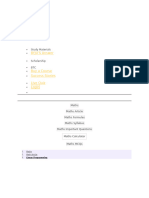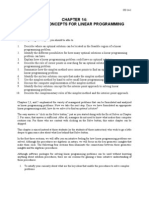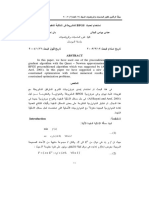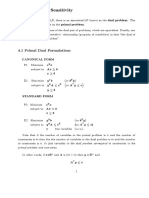Module 3 Lesson 3
Uploaded by
meyawella24Module 3 Lesson 3
Uploaded by
meyawella24Simplified Module in Management
Science
Module No.
Lesson No. 3
Standard Linear Programming Model:
Minimization Problem
3
Summer Class 2020
Angelita Mando
14 June 2020 Module 3: Linear Programming: Simplex Method
⮚ Steps ⮚ Summary ⮚ Problem/Solution
Steps in Solving Standard LP Maximization Model Using Simplex
Method
Steps in solving minimization problem are similar to maximization except for these 3
processes:
14 June 2020 Module 3: Linear Programming: Simplex Method
⮚ Steps ⮚ Summary ⮚ Problem/Solution
Summary of Converting Constraints to Equations in Minimization
Problem
1. Add an artificial variable (+A) if the symbol of the equation is =.
2. Add slack variable (+S) if the symbol of the equation is ≤ .
3. Subtract slack variable (-S) and add an artificial variable (+A) if the symbol is ≥ .
14 June 2020 Module 3: Linear Programming: Simplex Method
⮚ Steps ⮚ Summary ⮚ Problem/Solution
Summary of Converting Constraints to Equations in Minimization
Problem
- Artificial Variable will save slack variable from becoming negative. It prevents an equality
constraint from equating to 0.
- In minimization problem Slack Variables do not contribute any amount to cost.
- Artificial Variables contribute the biggest amount or coefficient to cost. Coefficients of an
artificial variable should be multiples of 10 or in the power of 10 ( example: 10, 100, 1000,
etc.) greater than any of the coefficients involve in the objective function and constraints.
- If slack (S) is (-) do not enter it on solution variables, prioritize the artificial variable.
14 June 2020 Module 3: Linear Programming: Simplex Method
⮚ Steps ⮚ Summary ⮚ Problem/Solution
Problem
14 June 2020 Module 3: Linear Programming: Simplex Method
⮚ Steps ⮚ Summary ⮚ Problem/Solution
Solution
Step 1 Construct the new program.
14 June 2020 Module 3: Linear Programming: Simplex Method
⮚ Steps ⮚ Summary ⮚ Problem/Solution
Solution
Step 1 Construct the new program.
1. We add the first slack ( S_1)on the first equation since the symbol of that equation is ≤ (less
than or equal to) to make the equation equal to 15.
2. Second slack ( S_2) (has been deducted and first artificial variable (A_(1) )has been added
to the second equation since the symbol of that equation is ≥ (greater than or equal to) to
make the equation equal to 16.
3. The Slack added on the 1st equation (S_1) and second slack deducted on the 2nd equation
were added to the objective function with 0 coefficient since slacks do not contribute any
The 1st artificial value 〖 (A 〗 _1) was also added to the objective function with 100 as the
amount to the cost.
coefficient since in the power of 10, 100 is greater than 60 (the greatest value among the
coefficient in the objective and constraints).
14 June 2020 Module 3: Linear Programming: Simplex Method
⮚ Steps ⮚ Summary ⮚ Problem/Solution
Solution
Prepare the initial table, then follow the same steps as in the maximization
Step 2 process.
14 June 2020 Module 3: Linear Programming: Simplex Method
⮚ Steps ⮚ Summary ⮚ Problem/Solution
Solution
Determine the optimum column or entering variable by choosing the most
Step 3 negative values in the Cj - Zj row.
14 June 2020 Module 3: Linear Programming: Simplex Method
⮚ Steps ⮚ Summary ⮚ Problem/Solution
Solution
Divide the quantity column values by the non-zero and non-negative entries in
Step 4 the optimum column.
14 June 2020 Module 3: Linear Programming: Simplex Method
⮚ Steps ⮚ Summary ⮚ Problem/Solution
Solution
Divide the quantity column values by the non-zero and non-negative entries in
Step 4 the optimum column.
14 June 2020 Module 3: Linear Programming: Simplex Method
⮚ Steps ⮚ Summary ⮚ Problem/Solution
Solution
Divide the quantity column values by the non-zero and non-negative entries in
Step 4 the optimum column.
14 June 2020 Module 3: Linear Programming: Simplex Method
⮚ Steps ⮚ Summary ⮚ Problem/Solution
Solution
Divide the quantity column values by the non-zero and non-negative entries in
Step 4 the optimum column.
14 June 2020 Module 3: Linear Programming: Simplex Method
⮚ Steps ⮚ Summary ⮚ Problem/Solution
Solution
Divide the quantity column values by the non-zero and non-negative entries in
Step 4 the optimum column.
14 June 2020 Module 3: Linear Programming: Simplex Method
⮚ Steps ⮚ Summary ⮚ Problem/Solution
Solution
Divide the quantity column values by the non-zero and non-negative entries in
Step 4 the optimum column.
14 June 2020 Module 3: Linear Programming: Simplex Method
⮚ Steps ⮚ Summary ⮚ Problem/Solution
Solution
Divide the quantity column values by the non-zero and non-negative entries in
Step 4 the optimum column.
14 June 2020 Module 3: Linear Programming: Simplex Method
⮚ Steps ⮚ Summary ⮚ Problem/Solution
Solution
Divide the quantity column values by the non-zero and non-negative entries in
Step 4 the optimum column.
14 June 2020 Module 3: Linear Programming: Simplex Method
⮚ Steps ⮚ Summary ⮚ Problem/Solution
Solution
Divide the quantity column values by the non-zero and non-negative entries in
Step 4 the optimum column.
14 June 2020 Module 3: Linear Programming: Simplex Method
⮚ Steps ⮚ Summary ⮚ Problem/Solution
Solution
Divide the quantity column values by the non-zero and non-negative entries in
Step 4 the optimum column.
14 June 2020 Module 3: Linear Programming: Simplex Method
END OF LESSON NO.
3
Any Questions?
14 June 2020 Module 3: Linear Programming: Simplex Method
You might also like
- Applied Mathematics For Business, Economics and Social Science55% (40)Applied Mathematics For Business, Economics and Social Science15 pages
- Module No.: July 2, 2021 Module 3: Linear Programming: Simplex MethodNo ratings yetModule No.: July 2, 2021 Module 3: Linear Programming: Simplex Method57 pages
- Graphical Method For Linear Programming ProblemsNo ratings yetGraphical Method For Linear Programming Problems19 pages
- Session-5 Simplex Method: University. All Rights ReservedNo ratings yetSession-5 Simplex Method: University. All Rights Reserved7 pages
- Analyzing of Water Resources Systems Using Linear Programming and Transportation MethodNo ratings yetAnalyzing of Water Resources Systems Using Linear Programming and Transportation Method21 pages
- 3.3a. Solving Standard Maximization Problems Using The Simplex Method - Finite MathNo ratings yet3.3a. Solving Standard Maximization Problems Using The Simplex Method - Finite Math16 pages
- Indian Institute of Technology Bombay Department of Electrical EngineeringNo ratings yetIndian Institute of Technology Bombay Department of Electrical Engineering10 pages
- Hindusthan College of Engineering and Technology: 16ma6111 & Operations ResearchNo ratings yetHindusthan College of Engineering and Technology: 16ma6111 & Operations Research13 pages
- operations research unit 1 and unit 2 Two marksNo ratings yetoperations research unit 1 and unit 2 Two marks17 pages
- MCA Mathematical Foundation For Computer Application 15No ratings yetMCA Mathematical Foundation For Computer Application 1512 pages
- Multi-Variable Optimization: Mathematical Modeling (STAT 420/620) Fall 2014 Lecture 3 - September 3, 2014No ratings yetMulti-Variable Optimization: Mathematical Modeling (STAT 420/620) Fall 2014 Lecture 3 - September 3, 201411 pages
- OOperations Research Unit 1,2,3 Two MarksNo ratings yetOOperations Research Unit 1,2,3 Two Marks37 pages
- Bulba Code ICE - RLHF Synthetic & Organic LossNo ratings yetBulba Code ICE - RLHF Synthetic & Organic Loss94 pages
- Study On Simplex Method and Design & Development of Application For Solving Simplex Problem Using PythonNo ratings yetStudy On Simplex Method and Design & Development of Application For Solving Simplex Problem Using Python4 pages
- Differentiate Simplex Method Maximization and Minimization ProblemsNo ratings yetDifferentiate Simplex Method Maximization and Minimization Problems2 pages
- Course Assessment Strategy Reference Practice BooklistNo ratings yetCourse Assessment Strategy Reference Practice Booklist4 pages
- Programming in Visual Basic (VB): For Visual StudioFrom EverandProgramming in Visual Basic (VB): For Visual StudioNo ratings yet
- Linear Programming: An Introduction to Finite Improvement Algorithms: Second EditionFrom EverandLinear Programming: An Introduction to Finite Improvement Algorithms: Second Edition5/5 (2)
- Duality and Sensitivity: 4.1 Primal Dual FormulationsNo ratings yetDuality and Sensitivity: 4.1 Primal Dual Formulations19 pages
- Tugas2 Regresi Linear Berganda - Ipynb - ColabNo ratings yetTugas2 Regresi Linear Berganda - Ipynb - Colab3 pages
- Analytical Decision Modeling For Business DecisionsNo ratings yetAnalytical Decision Modeling For Business Decisions35 pages
- Duality in Linear Programming 3 - Solved ExamplesNo ratings yetDuality in Linear Programming 3 - Solved Examples5 pages
- Optimization Techniques MCQs - Technicalblog - in100% (1)Optimization Techniques MCQs - Technicalblog - in4 pages
- Navjeevan - Ut2 Maths QB Solution by Pinnacle Engineering ClassesNo ratings yetNavjeevan - Ut2 Maths QB Solution by Pinnacle Engineering Classes39 pages
- Penerapan Kasus Algoritma Ascent Hill Climbing Dalam Permainan Puzzle 8 Yosdarso AferoNo ratings yetPenerapan Kasus Algoritma Ascent Hill Climbing Dalam Permainan Puzzle 8 Yosdarso Afero7 pages
- Final Ppts Daa Unit III Dynamic ProgrammingNo ratings yetFinal Ppts Daa Unit III Dynamic Programming36 pages
- Unit I Introduction: Mf7201 Optimization Techniques in ManufacturingNo ratings yetUnit I Introduction: Mf7201 Optimization Techniques in Manufacturing3 pages
- Applied Mathematics For Business, Economics and Social ScienceApplied Mathematics For Business, Economics and Social Science
- Module No.: July 2, 2021 Module 3: Linear Programming: Simplex MethodModule No.: July 2, 2021 Module 3: Linear Programming: Simplex Method
- Session-5 Simplex Method: University. All Rights ReservedSession-5 Simplex Method: University. All Rights Reserved
- Analyzing of Water Resources Systems Using Linear Programming and Transportation MethodAnalyzing of Water Resources Systems Using Linear Programming and Transportation Method
- 3.3a. Solving Standard Maximization Problems Using The Simplex Method - Finite Math3.3a. Solving Standard Maximization Problems Using The Simplex Method - Finite Math
- Indian Institute of Technology Bombay Department of Electrical EngineeringIndian Institute of Technology Bombay Department of Electrical Engineering
- Hindusthan College of Engineering and Technology: 16ma6111 & Operations ResearchHindusthan College of Engineering and Technology: 16ma6111 & Operations Research
- MCA Mathematical Foundation For Computer Application 15MCA Mathematical Foundation For Computer Application 15
- Multi-Variable Optimization: Mathematical Modeling (STAT 420/620) Fall 2014 Lecture 3 - September 3, 2014Multi-Variable Optimization: Mathematical Modeling (STAT 420/620) Fall 2014 Lecture 3 - September 3, 2014
- Study On Simplex Method and Design & Development of Application For Solving Simplex Problem Using PythonStudy On Simplex Method and Design & Development of Application For Solving Simplex Problem Using Python
- Differentiate Simplex Method Maximization and Minimization ProblemsDifferentiate Simplex Method Maximization and Minimization Problems
- Course Assessment Strategy Reference Practice BooklistCourse Assessment Strategy Reference Practice Booklist
- Programming in Visual Basic (VB): For Visual StudioFrom EverandProgramming in Visual Basic (VB): For Visual Studio
- Linear Programming: An Introduction to Finite Improvement Algorithms: Second EditionFrom EverandLinear Programming: An Introduction to Finite Improvement Algorithms: Second Edition
- Duality and Sensitivity: 4.1 Primal Dual FormulationsDuality and Sensitivity: 4.1 Primal Dual Formulations
- Analytical Decision Modeling For Business DecisionsAnalytical Decision Modeling For Business Decisions
- Navjeevan - Ut2 Maths QB Solution by Pinnacle Engineering ClassesNavjeevan - Ut2 Maths QB Solution by Pinnacle Engineering Classes
- Penerapan Kasus Algoritma Ascent Hill Climbing Dalam Permainan Puzzle 8 Yosdarso AferoPenerapan Kasus Algoritma Ascent Hill Climbing Dalam Permainan Puzzle 8 Yosdarso Afero
- Unit I Introduction: Mf7201 Optimization Techniques in ManufacturingUnit I Introduction: Mf7201 Optimization Techniques in Manufacturing
























































































